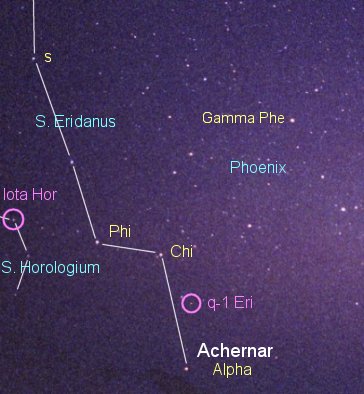 Iota Horologium is very similar to our own Sun, and has a Jupiter-
like planet that orbits in just under a year. The star seems to
have escaped from the Hyades star cluster.
Iota Horologium is very similar to our own Sun, and has a Jupiter-
like planet that orbits in just under a year. The star seems to
have escaped from the Hyades star cluster.
THE PLANET
The left-hand circle shows the location of the class G (G0) dwarf
star Iota Horologium, which is found in the deep southern end of
the constellation to the east of Eridanus,
Achernar, and another planet-holding
star, q1-Eridani. Iota Hor's planet, with
a mass at least 1.94 times that of Jupiter, orbits with a period of
311.3 days, or 0.85 years at an average distance of 0.91
Astronomical Units (136 million kilometers, 84.6 million miles),
not too much different from our own Earth. A modest orbital
eccentricity of 0.24 takes the planet from as far as 1.12 AU from
its parent star to 0.69 AU, from somewhat larger than the orbit of
the Earth to about the distance of Venus from the Sun.
|
 Iota Horologium is very similar to our own Sun, and has a Jupiter-
like planet that orbits in just under a year. The star seems to
have escaped from the Hyades star cluster.
Iota Horologium is very similar to our own Sun, and has a Jupiter-
like planet that orbits in just under a year. The star seems to
have escaped from the Hyades star cluster.
 Iota Horologium is very similar to our own Sun, and has a Jupiter-
like planet that orbits in just under a year. The star seems to
have escaped from the Hyades star cluster.
Iota Horologium is very similar to our own Sun, and has a Jupiter-
like planet that orbits in just under a year. The star seems to
have escaped from the Hyades star cluster.